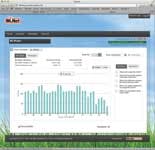| Alerts and access to information 24/7 can enable utilities to better identify leaks and quickly act to mitigate them before they turn into catastrophic breaks. |
Being able to locate and monitor distribution main leaks from the office can help utilities save time and resources by providing information they can use to more efficiently prioritize repair projects that will have the greatest impact in terms of reducing water loss.
Empowering Consumers
Keeping water bills down and accounting for household water usage is important to consumers. Results from a survey conducted by Woolcott Research found that more than 67 percent of consumers are concerned about the costs of residential water service and the need to conserve water.3
As a result, two-way AMI systems are increasingly featuring web-based portals that graphically present usage data to consumers. Information is displayed in formats that allow consumers to easily monitor their household water consumption, compare current usage to previous periods, configure individual alerts, and set budget and water conservation goals.
Recently, these portals have been deployed by the city of Bryant, Ark., the city of Maumee, Ohio, and other municipalities that are trying to help customers better understand their water bills and improve conservation. Customers can access the portal through their PCs or smartphones and monitor their household water usage in monthly, weekly, daily, and even hourly time frames.
By allowing customers to regularly monitor their usage, utilities can help them develop a sense of "normal" vs. "abnormal" usage levels. For example, if a customer happens to use a relatively large amount of water to pressure-wash their driveway or wash their car, they will be able to see the increased usage levels through the portal and better anticipate how much it will cost ahead of time rather than finding out when opening their bill. Likewise, if customers notice unusually high usage levels for which they have no obvious explanation, they can take appropriate action to see if a water leak has developed on their property.
Using Acoustics to Prevent Transmission Main Breaks
In addition to distribution main leaks, transmission main leaks are another major concern for utilities due to the high pressures involved and the potential for soil destabilization that can quickly turn a small leak into a large break. Transmission main breaks can be catastrophic; they can lose millions of gallons of water, require expensive and time consuming repairs, and damage property.
Traditionally, finding leaks and assessing the condition of large diameter transmission mains meant taking them out of service to conduct inspections. But some mains cannot be depressurized and drained for such inspections without major service disruption.
Fortunately, acoustic technology enhancements have been introduced and are being used by engineering firms and water utilities to non-invasively survey transmission mains and detect leaks of all sizes - all without breaking ground or disrupting service.
Fixed Transmission Main Leak Detection
Today, components of acoustic-based technology are being combined with GPS and cellular telemetry to create fixed transmission main leak detection networks - centralized networks that monitor transmission mains 24/7 - and alert utilities of leaks and transient events, so appropriate action can be taken before a catastrophic break occurs.
Essentially, a hydrophone is installed in the take-off port of valves in at least two locations along a transmission main, where synchronized recordings of acoustic signals are collected from the pipeline. Nodes installed within close proximity to the hydrophones store the recordings before generating reports that are periodically transmitted via cellular technology to the utility's server. If a leak is detected, the utility is quickly alerted of the size and location of the leak via email, text message or phone call, or through a web-based user interface.
Alerts and access to such information 24/7 can enable utilities to more efficiently identify leaks and quickly act to mitigate the leaks before they turn into catastrophic breaks. This can not only help reduce the occurrence of breaks that waste water and energy and threaten public safety but also save utilities time and resources, as they do not have to deploy service crews to manually survey transmission mains.
Conclusion
The ability for utilities to properly assess and control water losses and provide customers with ways to better conserve water is extremely important, as water consumption is expected to increase approximately 40 percent by 2025, according to the World Water Forum.
Recent AMI and acoustic technology innovation creates a "win-win" scenario for utilities - it can help them reduce water loss and minimize their carbon footprint while improving operational efficiencies in ways that can ultimately save them time and resources.
About the Authors: Matt Thomas is Vice President of Marketing for Cleveland, NC-based Mueller Systems. Marc Bracken is Vice President and General Manager for Toronto-based Echologics.
References
1. Veronica Blette, Jason Turgeon, Wendy Wilson. Saving Water & Energy – Reducing Greenhouse Gases by Improving Efficiency. U.S. EPA & The Watershed Academy, Webcast, May 17, 2011.
2. Gregory M. Baird. "Fight Back Against Rising Water Bills." National Taxpayers Union Newsletter, Dollars & Sense. Fall 2011/Winter 2012.
3. Testing the Water: Smart Metering for Water Utilities," Oracle and Woolcott Research. January 2010.





